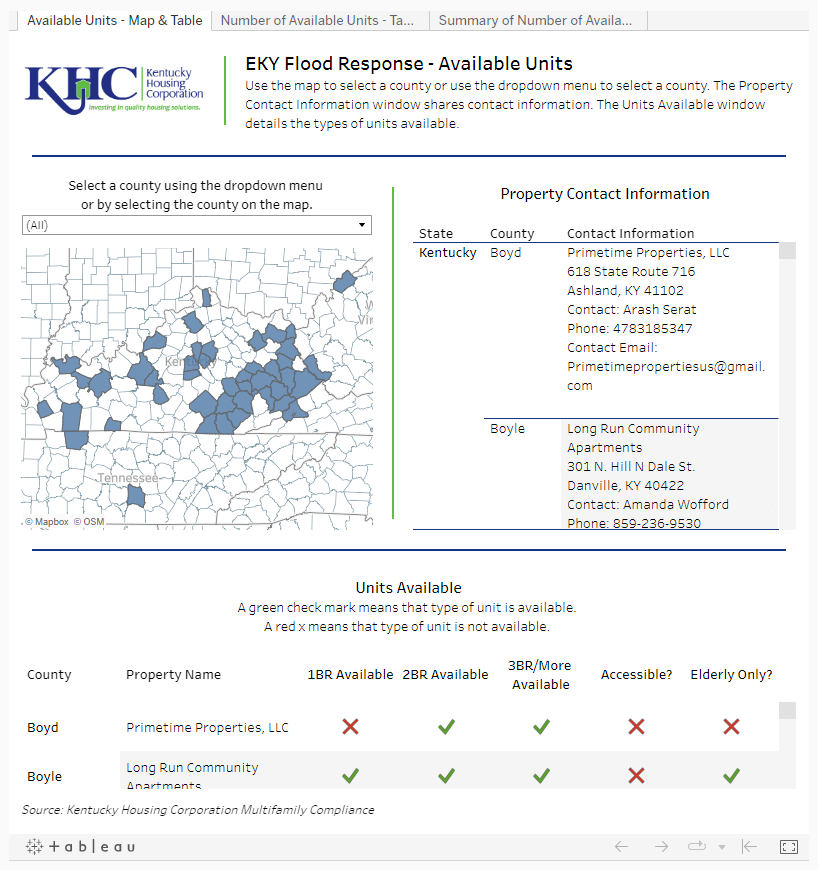After tornadoes in western Kentucky, many people were left homeless. Kentucky Housing Corporation, with help from partners, created a dynamic dashboard to help those people find permanent housing.
KHC's Disaster Response Housing Dashboard
In December 2021, a volatile storm system that formed in central Arkansas traveled due northeast into western Kentucky, introducing several tornadoes along the way, including one that traveled over 200 miles. In Mayfield, a tornado leveled a candle factory before passing directly through the center of downtown. In Bowling Green, to the east, where winds were measured at more than 150 miles per hour, 475 homes were destroyed and another 500 damaged. In Dawson Springs alone, 75% of homes were lost. The housing situation in eastern Kentucky changed overnight. Suddenly, over a thousand residents were homeless.
The short-term solution, spearheaded by the Red Cross, the Federal Emergency Management Agency (FEMA), and Kentucky Emergency Management, was to house the newly homeless in state parks, hotels, and trailers. This is a vital but temporary solution. Damage to infrastructure, apartment buildings, houses, entire swaths of the community, was so great, though, that there needed to be a long-term solution for people whose homes were completely destroyed or damaged beyond repair. They could stay in lodges for only so long. Eventually, they were going to need a place to live.
Kentucky Housing Corporation (KHC) is not a disaster, recovery, or first-responder agency, but it was and is uniquely positioned, given decades of connections across the state with landlords, apartment complex managers, developers, housing authorities, and non-profit organizations, to connect people without homes to people who have homes to spare. A few days after the tornadoes, KHC staff created a plan to bring their resources to bear on the housing side of the disaster.
“We know a lot of people, we know a lot of projects, a lot of apartment complex landlords,” said Joe Prichard, managing director of multifamily compliance at KHC. “We reached out to every partner we’ve ever had in western Kentucky to see if they had available units.”
They also took inventory of which KHC projects had been affected in western Kentucky. “We were looking to see if the people we housed, the complexes we funded, were affected,” he said. He recalled that one—Eloise Fuller in Mayfield, a federally subsidized apartment building—was completely devastated.
When they were notified about a vacancy, they added it to a list. After the first week, they had found between 200 and 300 available units. At its zenith, the list reached 585 units in 74 counties.
“We found a lot of units at a time when people were saying there aren’t any units,” said Prichard. “Landlords were super willing to share if they had anything available, or something they were working on that they could get ready quickly.” It was an incredibly generous response.
The list started out as a simple spreadsheet and distributed as a PDF, an inelegant but practical solution in the moment; but as the list grew, it became clear that a more sophisticated, public-facing database was appropriate. People who were looking for housing needed a single place they could go to find it. They needed it to be easy at a time when a lot of things in their lives were not.

The solution was a dynamic database housed on KHC's website. PDFs can be easily distributed through email, but the information within them can quickly become outdated. Prichard's team worked closely with Erica Yan, data and reporting analyst at KHC, to create an interactive, mobile-friendly, updateable dashboard that anyone could use to search for permanent housing. The dashboard was created using a program called Tableau, a data analysis tool focused on data visualization.
"One of the benefits of using Tableau," said Yan," is that users can use filters to drill down to the data they want to see." They can use the dropdown menus to search for available units by county and state as well as by bedrooms, accessibility, and age restrictions. More visually inclined users may choose to browse the map, clicking on highlighted counties to obtain the addresses and contact information for landlords and particular properties in that area. Yan said these dynamic features allow storm survivors to find the information they want more quickly than scrolling through a long list of properties, which may prove daunting. The navigation requires very little aside from clicking or tapping and scrolling.
Once the dashboard was live, Prichard and his team worked with the U.S. Department of Housing and Urban Development (HUD), Red Cross, and FEMA to distribute it. In addition, the media was incredibly generous, providing free airtime for public service announcements and letting Prichard and other KHC administrators discuss the dashboard.
For months the list was updated weekly. When availability began to stabilize, they updated it less frequently. A little over eight months after the tornadoes, though, unprecedented rainfall in eastern Kentucky led to widespread flooding in 13 counties. The result was the same as it was after the tornadoes: Kentuckians were left without a home. Prichard and his team went to work on a new dashboard. They called landlords; they talked to partners; and they took stock of affected KHC-funded projects, just like they did after the tornadoes.

Experience had taught them that survivors are not ready to start looking for permanent residence, to sign a lease and replace what belongings they might need, right after the disaster, so they took a few days to refine the original design, retooling it for the flood response in an attempt to make it even more user-friendly. The current design was arrived at after several iterations, which, says Yan, is the nature of data visualization.
"Sometimes you start with something in mind, but the data takes shape in a different way as you’re visualizing it," she said. Previous versions included less user-friendly maps, colors, and symbols, all of which were scrapped when a better solution arose. "I wanted to create something that everyone could use," she said, "from the people who are actively searching for housing, to those providing assistance, and to KHC staff to other stakeholders."
KHC's partners in eastern Kentucky are even more numerous than in western Kentucky. Like the previous list, this one grew considerably within days, reaching 404 units in 43 counties. As it evolved, the list was widened to include available units from counties in western West Virginia and Virginia and northeastern Tennessee, all areas adjacent to the flooding in Kentucky.
The dashboard has been an incredibly useful resource for Kentuckians in need and, for the time being, is still live on the website. Prichard, Yan, and the KHC team that worked on the dashboard project hope that it will serve as a blueprint or at least a best practice for other state housing finance agencies that may one day need to address the unique challenges of post-disaster housing.
If you or anyone you know is still looking for housing after the flooding, visit the dashboard to see what properties and units are available.
Article by Steve Morrow
To read more about how KHC is helping disaster recovery efforts in Bowling Green, click here.

